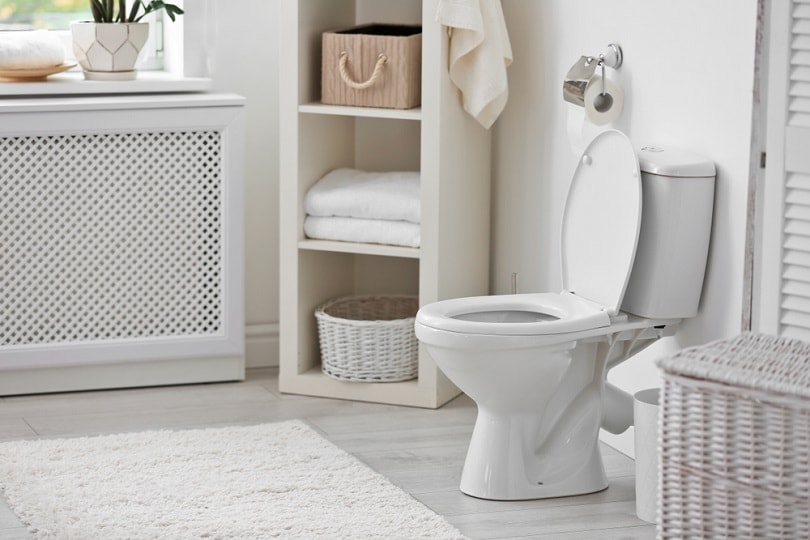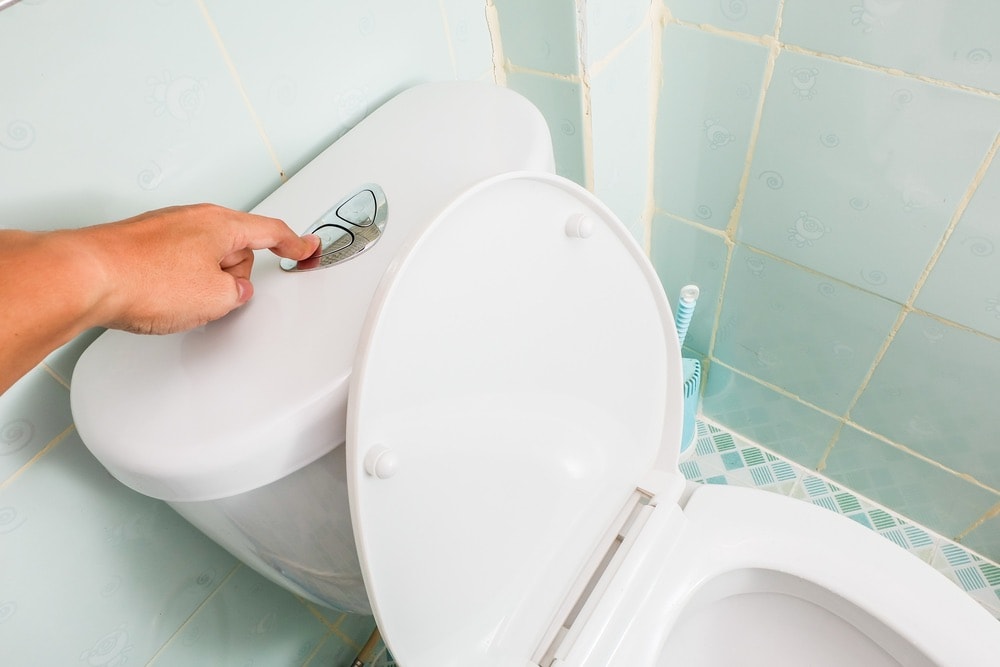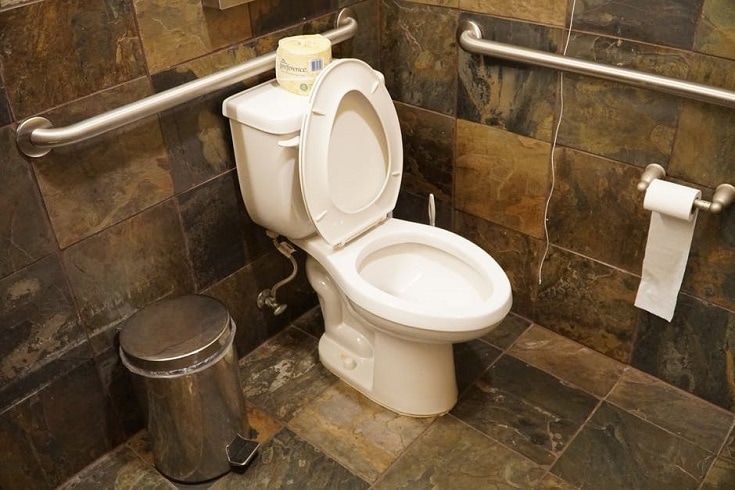Why Is My Toilet Leaking From the Base? 4 Possible Reasons
-
Pete Ortiz
- Last updated:

Homeowners know that water in the wrong places is always a cause for concern. Large floods and small drips can cause hundreds or thousands of dollars in damage once they start touching your home’s foundation.
That’s why a leaking toilet base needs immediate attention. Whether it’s gushing water whenever you flush or slowly trickling every once in a while, a leak is likely causing cumulative damage to an expanding section of subfloor beneath it. It doesn’t take long for damage to set in, but fortunately, it also doesn’t take much time to repair!
To help you get your water problem under control, we’ll walk you through four probable causes of a leaking toilet and what you can do to fix them.
The 4 Possible Reasons Why Your Toilet Leaking From the Base
1. Condensation Buildup
Sometimes, water on the floor isn’t a leak issue at all. Condensation may have built up on the tank or bowl and caused moisture to drip to the toilet’s base.
Try to root out the source of the leak. Dry up any water around the base and wait for the water to pool again. A quick test is to soak up all of the water and flush the toilet. If water doesn’t begin to pool around the base immediately and there aren’t any leaks from the tank, bowl, or supply line, condensation is likely the problem.

- How to Fix a Sweating Toilet
Toilets collect condensation because the water inside the bowl or tank is colder than the bathroom air. It attracts moisture from the air that settles as condensation and drips to the floor. You may see this from a constantly running toilet because the cold water from the supply line keeps cycling, never having a chance to warm up.
Try these tips to reduce condensation buildup and reduce pooling at the base of your toilet:
- Make sure the flapper isn’t faulty and replace it if needed
- Insulate the water tank
- Improve bathroom ventilation
- Use a dehumidifier
You can add a drip tray to the toilet base in a pinch to keep runoff from reaching the floor; it’s a temporary solution as you find an effective fix.
2. Cracked or Unsealed Toilet Parts
If condensation isn’t the culprit, you may notice a leak from the base or another toilet part. It may leak continuously or only when you flush. In some instances, the bottom, bowl, or tank could have a crack, and you will need to replace the toilet.

- How to Fix a Cracked or Unsealed Toilet
A loose or damaged seal on an otherwise undamaged toilet is a relatively quick repair. Tighten the water supply line to the tank if it is causing the leak. If the connection from the tank to the bowl causes the leak when you flush, follow these steps to fix the problem:
- Turn the water supply line off
- Flush the toilet and sop up any remaining water from the tank
- Disconnect the water supply line
- Remove the tank nuts from the underside of the tank where it connects to the bowl
- Carefully remove the tank
- Clean the bottom of the tank around the O-ring (or mack washer) and replace the rubber gasket
- Line up the tank bolts with the holes in the bowl and reattach the nuts to secure the tank in place
- Attach the water supply line to the tank and turn it on
- Let the toilet tank fill and flush it once to check for a leak
3. Loose Closet Bolts
When there are no cracks in the toilet or damage to the seals, you may have a loose connection to the flange in the floor. Wiggle the toilet gently to see if it rocks or shifts. A loose toilet can open up enough of a gap in the wax seal to let water seep onto the floor.

- How to Fix Loose Toilet Bolts
Closet bolts attach to the toilet at the base toward the rear. There will be one bolt on either side of the base. Use a flathead screwdriver to pry the caps off the bolts.
Tighten the bolts with pliers, and apply firm pressure to the nut, but turn them slowly and gently. Alternate from one bolt to the other, tightening each little by little. Overtightening the nut can crack the base and force you to buy a new toilet.
Once tightened, carefully rock the toilet to see if it moves. If it feels sturdy, give it a test flush to ensure the leak doesn’t return.
4. Faulty Toilet Seal
The most likely cause of a toilet leaking from the base is a broken or loosened wax seal. A wax ring seals the connection between the toilet and the sewer pipe in your home’s plumbing. Over time, this seal can become stiff or loosen, allowing a pocket to open for water to seep out every time you flush the toilet.

- How to Fix a Faulty Toilet Seal
You’ll have several options for replacing your wax ring. Some products are simple wax rings, while others have attached fittings or cores to aid installation. If you don’t like the idea of working with wax, you can opt for a silicone ring instead.
- Turn off the water supply line running to the tank and flush the toilet
- Sop up any remaining water from the toilet bowl or use a water solidifier to harden the water and make it safe to remove
- Disconnect the water supply line from the tank and unscrew the closet bolts at the base of the toilet
- Hold the toilet and gently wiggle and rock it loose from the wax seal
- Grab the toilet firmly from the underside of the bowl, lift it from the bolts, and set it aside
- Pull the wax ring off of the floor flange
- Use a narrow putty knife to scrape off any remaining wax from the floor, flange, and underside of the toilet, if you plan to reuse it
- Check that the flange isn’t damaged and in need of replacement
- Install a new wax ring to the flange, ensuring it’s perfectly centered over the hole
- Carefully reinstall the toilet over the closet bolts, and sit down on the toilet to compress the wax ring and create a tight seal
- Reattach the closet bolt nuts and supply lines, fill the tank, and flush to check for leaks
Conclusion
A toilet leaking from the base is inexpensive and straightforward to repair for the capable DIYer. Even the most complex project of swapping out a wax ring often costs under $10 in parts and takes less than an hour to complete.
With that in mind, plumbing services are also usually reasonable for this project. There’s plenty of peace of mind knowing you’re in professional hands. But no matter how you approach the chore, it’s crucial to take care of the leak immediately to prevent more expensive repairs down the line.
- See also: 10 Reasons Plant Leaves Turn White
Featured Image Credit: cunaplus, Shutterstock
Contents



